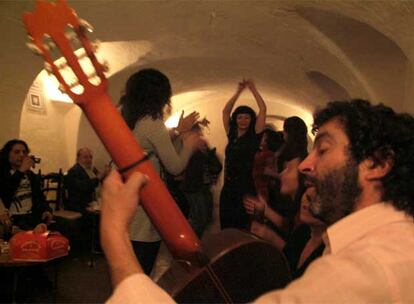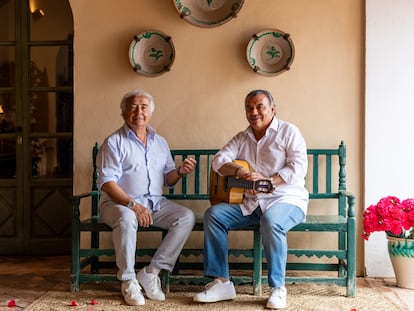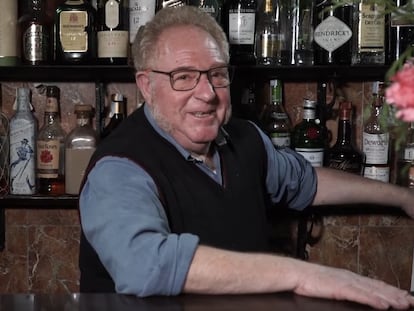Madrid’s Bar Candela, legendary venue for flamenco, closes after 40 years
The iconic establishment helped fuel a revolution of the genre in the 1980s and attracted global figures of jazz and dance such as Chick Corea and Pina Bausch

There are only a few places that manage to dwell in the minds and hearts of those who took refuge within their walls. Bar Candela, a venue in the Lavapiés neighborhood of Madrid that closed last week, was such a place; an iconic flamenco hangout whose unique atmosphere was nurtured by its founder, Miguel Aguilera Fernández – aka Miguel Candela – who was loved by all who knew him. The magical nights in la cueva (the cave), the basement of the bar, became legendary and their protagonists share a vivid collective memory of anecdotes worth treasuring.
Open for almost 40 years, the Candela went through many different stages but, for a time, it became the go-to haunt or, in other words, “the common casita for flamenco artists from all over Spain, who had been coming to Madrid to look for a future since the 1980s,” as the guitarist, writer and producer José Manuel Gamboa explains, adding that he himself spent more time there than in his own home during that period.
The guitarist Gerardo Núñez was another of those who decided to carve a niche for themselves in the capital’s flamenco scene, and he found the Candela an ideal stomping ground in which to grow artistically. “All the guitarists and flamenco artists in Madrid went to the Candela, as well as those who were just passing through,” he says. “It became a place of homage and the temple of flamenco guitar. In the cave, amid a sepulchral silence and extreme respect, authentic concerts went on until 6am or 7am.”
Nothing is eternal, gentlemen, so get used to the ideaMiguel Aguilera Fernández, owner of Bar Candela
Besides being a place to hang out, the bar was also a rehearsal room. “Miguel [the owner] was a good aficionado and totally understood the idiosyncrasies of the flamenco artists,” adds Nuñez. “He allowed us to use the space to rehearse and to give dance and guitar lessons without charging us.” Flamenco dancer Joaquín Grilo had a similar experience and was even given a key to the premises so he could let himself in to rehearse in the mornings. “Miguel was like a brother to me,” he says. “I learned a lot there, both artistically and personally.”
The Candela basement was essentially a space where the artists shared their music. Núñez describes how they would meet there to show each other their new compositions. “There was a lot of rivalry,” he adds. “It was a jungle: we were going at it to the death, because we had to stand out to make a place for ourselves, but we always did so respectfully and politely. We nurtured each other, and the older ones came to learn something new from the young ones.”
The Candela became the stage for much of the flamenco guitar revolution. With the coming together of today’s maestros, such as Rafael Riqueni, Juan Manuel Cañizares and the aforementioned Núñez, the seeds of the generation that would succeed that of Manolo Sanlúcar, Víctor Monge Serranito and Paco de Lucía were sown. For this and other reasons, Gamboa states categorically that “the Candela was the place that turned everything upside down: the flamenco we have today is, to a great extent, thanks to the Candela.”

All the witnesses of those days agree that the singer Enrique Morente played a central role in creating the Candela’s mystique. “It was hugely lucky that he was there almost every day and night, even if it was a sign that he was not working much at that time,” says Gamboa, who adds that despite not having much work, Morente plowed his earnings into helping young artists. “He was the only one of the renowned artists who truly supported the young,” he adds. This is corroborated by Núñez, who describes how Morente hired him for a performance at the Teatro Real opera house.
Another key figure during that era was the Granada-born guitarist Pepe Habichuela, who brought along the photographer and record producer Mario Pacheco to meet his son Juanmi and his nephews Antonio and Juan Carmona. These three would go on to join the band Ketama, considered a leading exponent of new flamenco.
Another regular visitor who would drop by when he was in Madrid was the guitar virtuoso Paco de Lucía, who chose the bar to celebrate his birthdays. The story that best illustrates his relationship with the place was the one that marked his return to the guitar after a diving accident in Mexico, which threatened to retire him from playing for life. Gamboa explains that while Paco still had his arm in a cast, the pair were in the Candela’s kitchen when Paco suddenly asked Gamboa if the house guitar had strings and if he would tune it up while he went to get his cast off. When he returned, he picked up the guitar and, without thinking twice, astonished the staff with one of his incredible picados.
The small hours of the morning
The Candela was depicted in a unique way in the show De noche (como quien espera el alba) by the Jerez-born dancer Joaquín Grilo. The show premiered in 2001 as part of the Jerez Festival and later came to Madrid for a season. De noche paid explicit tribute to the Candela’s all-night sessions, recreating its atmosphere and depicting the bewitching encounter between art and recognizable nocturnal characters who would immerse themselves in it. Grilo explains that he focused on the venue’s unique character, with its parties and “many chats.”
Aside from the inevitable flamenco – with compositions by Paco de Lucía and Bolita – the dancer adds that he also tried to convey Candela’s affinities with the jazz scene to be found at the nearby venues Café Central and Café Berlín. The show is remembered as a symbol of the eclectic vibe that prevailed in Candela’s cave, where representatives from all artistic disciplines met, including the jazz composer and pianist Chick Corea, the maestro guitarist Sabicas on his return from New York, the movie director Pedro Almodóvar and the German choreographer Pina Bausch.
In 1991, when the first Gulf War broke out, Bausch spent some time in Madrid preparing a new choreography and she went to the Candela every night. Miguel, the owner, had the TV on so that everyone could watch the news, and the dancer often cried at the images. Gamboa says they would spend the nights singing and talking to cheer her up. When the choreographer later presented her show at the Teatro de la Zarzuela, she dedicated it to the Candela tribe: Miguel, Morente, Gamboa and Juan Verdú, one of the most important figures behind the post-Franco regeneration of flamenco.
In March 2008, Miguel Candela died “accidentally by the force of fate,” as his great friend, the singer Enrique Morente, put it when he dedicated his recording to him that year: Pablo de Málaga. Perhaps, in closing, it is necessary to resort to the words of Miguel himself, who would bid farewell to his friends every dawn with the familiar phrase: “Nothing is eternal, gentlemen, so get used to the idea.”
Tu suscripción se está usando en otro dispositivo
¿Quieres añadir otro usuario a tu suscripción?
Si continúas leyendo en este dispositivo, no se podrá leer en el otro.
FlechaTu suscripción se está usando en otro dispositivo y solo puedes acceder a EL PAÍS desde un dispositivo a la vez.
Si quieres compartir tu cuenta, cambia tu suscripción a la modalidad Premium, así podrás añadir otro usuario. Cada uno accederá con su propia cuenta de email, lo que os permitirá personalizar vuestra experiencia en EL PAÍS.
¿Tienes una suscripción de empresa? Accede aquí para contratar más cuentas.
En el caso de no saber quién está usando tu cuenta, te recomendamos cambiar tu contraseña aquí.
Si decides continuar compartiendo tu cuenta, este mensaje se mostrará en tu dispositivo y en el de la otra persona que está usando tu cuenta de forma indefinida, afectando a tu experiencia de lectura. Puedes consultar aquí los términos y condiciones de la suscripción digital.
More information
Archived In
Últimas noticias
Most viewed
- Sinaloa Cartel war is taking its toll on Los Chapitos
- Oona Chaplin: ‘I told James Cameron that I was living in a treehouse and starting a permaculture project with a friend’
- Reinhard Genzel, Nobel laureate in physics: ‘One-minute videos will never give you the truth’
- Why the price of coffee has skyrocketed: from Brazilian plantations to specialty coffee houses
- Silver prices are going crazy: This is what’s fueling the rally










































